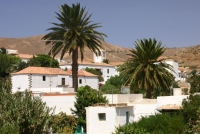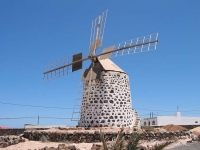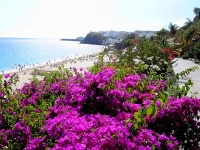Fuerteventura Travel Guide
Fuerteventura is a dreamscape of spectacular volcanic terrain and white-sand beaches, and only 60 miles (100km) separate it from Africa. This sunny island has the same latitude and similar weather conditions as Florida and Mexico, so visitors can expect a gloriously warm climate year round, as well as marvellous opportunities for wind surfing and scuba diving.
Unlike those bustling resort-ridden holiday stations, much of Fuerteventura is relatively undiscovered, with more than 150 idyllic sandy beaches only sparsely populated and many seldom visited at all. The name of the island comes from the strong trade winds, which have made it a popular stop for windsurfing and kite surfing enthusiasts.
The island has an arid volcanic landscape and, apart from the beautiful beaches and a handful of developed tourist areas, not much to recommend it by way of tourist amenities or attractions. This has kept the mega resorts and mass summer package-holiday trade at bay, but Fuerteventura does have a fair share of day trippers from the resorts of Lanzarote and Gran Canaria who come seeking a respite from the crowds.
Fuerteventura is the ultimate Canary Islands destination for those who want to get away from civilisation and crowds, and enjoy a sleepy, sunny holiday. The island's two main resort towns are Corralejo and Caleta del Fuste. Fuerteventura is easily accessible from the other islands in the archipelago by ferry or air. The Fuerteventura airport is situated close to the island's capital of Puerto del Rosario.
Things to do in Fuerteventura
Fuerteventura is famous for its gorgeous beaches, which range from stretches of white sands in the south to the odd black-sand beaches in the north. There are also charming little villages and harbours to enjoy, and a laidback ambiance characterises the entire island. Fuerteventura doesn't have the glamorous nightlife or high-end attractions of some other Balearic destinations, but those visiting to enjoy its wholesome charms will not be disappointed.
Puerto del Rosario is the main town and the most popular resorts are Correlejo and Caleta del Fuste. However, to really experience local charm, visitors should head to rustic little villages such as El Cotillo and La Oliva, or the historic old town of Betancuria.
The island's regular winds make it a good destination for water sports such as windsurfing and kite surfing, and other fun activities include glass-bottomed boat adventures and camel rides on the beach. Families travelling with kids should try out the Baku Water Park and Fuerteventura Oasis Park.
Car hire is good value and most visitors tend to rent a vehicle by the week to get around Fuerteventura at their leisure. Public transport is decent, though, with reliable and cheap buses, and ferries that are useful for getting from one side of the island to the other.

Betancuria
The old town of Betancuria was founded in 1405 and was the first capital of Fuerteventura. The town enjoys a fantastic location that offers attractive views of the hilly terrain and winding river below. There are several beautiful buildings and churches worth visiting in the town, including the Church of Iglesia de Santa Maria de Betancuria and the convent of San Buenaventura. The Casa Museo Arquebiologico has some interesting artefacts including fertility idols and farming tools that reflect the earliest history of the island. The town was built primarily to defend against pirate attacks was all but destroyed by pirates in 1593. There are various shops and stalls in Betancuria that sell some of the best handcrafts and local produce on Fuerteventura.

La Oliva
Historic buildings from between the 17th and mid-19th centuries remain in the village of La Oliva, which people can still visit. Travellers should make their way to the centre of the village, where they'll find the pretty church of Parroquiade Nuestra Seiiora de Candelaria. Its highlights include a square bell tower, a finely carved wooden door, an interior that features a painting of the Last Judgement, a Baroque altar painting by Juan de Miranda, and some wonderful trompe l'oeil work. The village also has an art centre exhibiting the work of Canarian artists (Centro de Arte Canario Casa Mane). The somewhat desolate and barren natural landscape of the interior gives way dramatically to the bright turquoise water of the sea, and the beaches around La Oliva are very pretty.

Beaches on Fuerteventura
Travellers won't need to go far on Fuerteventura to find a perfect beach, even if they are intent on seeking solitude from other holidaymakers. The best are found around Jandia on the southern tip of the island. Juan Gomez is one of these and has an enticing stretch of golden sand. The black-pebble volcanic beach of La Pared is in the same part of the island. Giniginamar is surrounded by palm trees and other indigenous plants and is recommended for peace and quiet. If travellers are looking for a family-friendly beach, the southern Costa Calma is a great option as the conditions are ideal for safe swimming and the facilities are good. Nudism is tolerated on all the island's beaches.
Shopping
Although the island doesn't have the same concentration of shops as the more developed Canarian destinations such as Gran Canaria and Tenerife, there are still some decent shopping venues in the tourist centres of Fuerteventura.
The main resort town of Caleta de Fuste has the enormous Atlantico shopping centre, which has the usual chain stores found in large European cities. The resort of Puerto del Rosario has the island's largest shopping centre, Las Rotondas, where there's over 100,000 square feet (30,000 square metres) of retail space.
Away from the glitzy, generic world of the shopping malls are the markets where Fuerteventura reveals some of its personality. The markets of Corralejo, Caleta, Morro Jable and Costa Calma are worth browsing for fresh produce, pottery and textiles.
Shopping centres on Fuerteventura tend to have tiny entrances to combat the strong dusty winds that blow through town, so visitors shouldn't be fooled by small doors! Shops tend to open from 10am to 10pm, with smaller stores closing over lunch for siesta.
Getting Around
There are very few transport options available on the island of Fuerteventura. Public transport is limited to buses, which operate across the island. Buses serving Nuevo Horizonte, Corralejo, Caleta de Fuste, Morro Jable, and Costa Calma run most frequently. For other routes, passengers should consult a timetable. Those who plan on using buses regularly during their stay should invest in a 'BTF Bono' card.
Taxis are available on the island and can be found at most busy locations or pre-booked ahead of time. As taxis can become quite expensive, travellers should consider the option of hiring a car in Fuerteventura, as this won't only save money but give them the freedom to explore the island at a more leisurely pace. There are lots of car hire companies with offices at the airport.
Fuerteventura Climate and Weather
Fuerteventura has a glorious climate all year with temperatures rarely dropping below 63°F (17°C) and often rising above 82°F (28°C) during the day. Gentle sea breezes keep the island from being too hot and extreme temperatures are rare.
During the winter months, December to February, average temperatures range between 59°F (15°C) and 72°F (22°C). In the peak summer months, from June to August, average temperatures range between 68°F (20°C) and 82°F (28°C).
Rainfall in the summer months is almost non-existent, but showers are possible between October and April. Over the winter months, travellers will need a sweater and light trousers for evenings and possibly the odd rare cloudy day. Any other time of year, visitors will only need the bare essentials such as shorts and T-shirts.
Occasionally, sand-laden winds blow across Fuerteventura from the Sahara and can cause a rise in temperature and poor visibility. The best and most popular time to visit Fuerteventura is between May and September, but the mild climate makes the island a wonderful holiday destination all year.
Spain travel info
Electricity
The electrical current is 230 volts, 50Hz. European-style two-pin plugs are standard.
Language
Spanish is the official language, but English is widely understood in areas frequented by tourists. Catalan, Galician and Basque are spoken in the relevant areas.
Money
Spain's official currency is the euro (EUR), which is divided into 100 cents. Money can be exchanged at bureaux de change and major hotels, but banks give the best rates. All major credit cards are widely accepted at most hotels, restaurants, and shops. ATMs are widespread and are generally the cheapest and most convenient method of obtaining money.
Tipping
Hotel and restaurant bills usually include service charges, but additional tips are welcomed for services rendered. In established restaurants, tips of about 10 percent are expected. Drivers of metered taxis expect small tips and it's customary to tip about 5 to 10 percent for most services, including guides.
Health
There are no health risks associated with travel to Spain, and no vaccination certificates are required for entry. Medical facilities are good but comprehensive travel insurance is always advised. Spain has a reciprocal health agreement with most EU countries that provides emergency health care for EU travellers on the same terms as Spanish nationals. After Brexit, the Global Health Insurance Card (GHIC) replaced the European Health Insurance Card (EHIC) for UK citizens. The GHIC allows UK citizens access to state healthcare during visits to the EU. The GHIC is not valid in Norway, Iceland, Liechtenstein or Switzerland, nor is it an alternative to travel insurance. EU travellers should take a European Health Insurance Card (EHIC). Travellers should take any medication they require along with them, in its original packaging and accompanied by a signed and dated letter from a doctor detailing what it is and why it is needed.
Safety
Most visits to Spain are trouble-free except for occasional street crime. Petty crime, such as pickpocketing and purse snatching, is most common in larger cities, particularly during holidays, festivals and weekends, and especially on public transport and in tourist areas. Thieves may work alone or in groups; visitors should be wary of strangers who offer or ask for help of any kind, or inform them of a stain on their clothes, as these are often ways of providing a distraction for accomplices. There are also scams involving letters for outstanding traffic fines or Spanish lottery winnings. Travellers can avoid incidents if they exercise all the normal precautions.
Local customs
Smoking in public places is banned and stiff fines will be imposed for smoking in areas such as enclosed public spaces, areas where food is prepared and sold, public transport, non-smoking areas of bars and restaurants, and any places that cater for children. Drinking alcohol in the streets of Madrid and the streets of the Canary and Balearic Islands is illegal.
Doing business
The business culture in Spain is slowly shifting but, for now, it's entrenched in tradition and it can take some time for foreigners to gain a foothold in the Spanish working world. It's important never to undermine authority as hierarchy is central to Spain's business world. Managers tend to make decisions without considering input from their colleagues.
A strong emphasis is placed on social status, character attributes, and personal pride. Success is often hinged upon being well-dressed, honourable, and dignified, while also exhibiting great social skills. Business meetings are generally conducted face-to-face and can go on for long periods, as Spaniards prefer long deliberations in order to avoid uncertainty in corporate dealings. Business meetings in Spain tend to tread a fine line between personal and formal.
Conducting business in Spain can entail navigation through a lot of red tape and bureaucracy. Spanish is the language of business, but some of the larger multinationals conduct meetings in both English and Spanish. Business hours are often quite varied, but generally open by 9am and close in the mid-evening with a two-hour lunch break during the early afternoon.
Business attire is quite conservative with men wearing dark or linen suits, shirts and silk ties. Women should wear modest dresses or tailored suits. Brand names or labels attract affirmation from colleagues and associates.
After the conclusion of successful negotiations, gifts are appropriate. Gifts should be of high quality and, when receiving a gift, it should be opened in front of the giver. Business cards are important and should be bilingual. Meetings are best scheduled for mid-morning, and establishing a formal yet personable environment is important before beginning. Meetings often occur over lunches and dinners.
Duty free
Travellers from EU countries are allowed the following items duty free: 800 cigarettes or 400 cigarillos or 200 cigars or 1kg tobacco; 110 litres beer; 90 litres wine; and 10 litres spirit. Travellers from non-EU countries may have 200 cigarettes or 100 cigarillos or 50 cigars or 250g tobacco; 1 litre spirits, 4 litres wine, and 16 litres beer.
Communications
The international access code for Spain is +34. WiFi is widely available; travellers can purchase local SIM cards for unlocked phones or use eSIMs if their cellular providers support it on their networks.
Passport & Visa
The borderless region known as the Schengen area includes the following countries: Austria, Belgium, Czech Republic, Denmark, Estonia, Finland, France, Germany, Greece, Hungary, Iceland, Italy, Latvia, Lithuania, Luxembourg, Malta, The Netherlands, Norway, Poland, Portugal, Slovakia, Slovenia, Spain, and Sweden. All these countries issue a standard Schengen visa that has a multiple entry option, allowing the holder to travel freely within the borders of all. Non-EU nationals must hold a return or onward ticket, all necessary documents for onward travel and sufficient funds. It is highly recommended that passports have at least six months' validity remaining after the intended date of departure from Spain. Immigration officials often apply different rules to those stated by travel agents and official sources.
Entry requirements
United States citizens require a passport valid for three months beyond the period of intended stay. No visa is required for stays of up to 90 days within a 180 day period.
British citizens require a passport valid for three months beyond the period of intended stay. No visa is required for stays of up to 90 days within a 180 day period.
Canadian citizens require a passport valid for at least three months beyond period of intended stay. No visa is required for stays of up to 90 days within a 180 day period.
Australian citizens require a passport valid for at least three months beyond period of intended stay. No visa is required for stays of up to 90 days within a 180 day period.
South African citizens require a passport valid for at least three months beyond period of intended stay. A visa is required.
Irish nationals require a valid passport, but a visa is not necessary.
New Zealand citizens require a passport valid for at least three months beyond period of intended stay. No visa is required for stays of up to 90 days within a 180 day period.
Useful contacts
Spanish Tourist Office, Madrid: www.spain.info.
112 (General).


